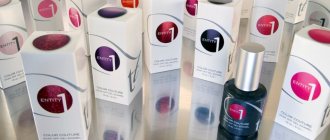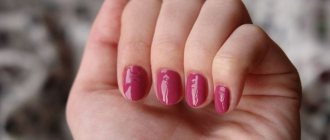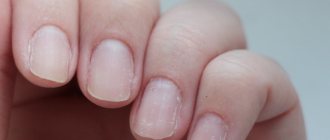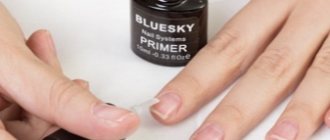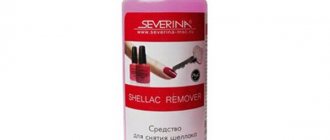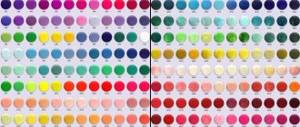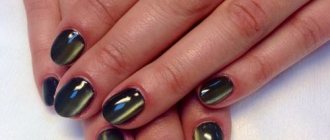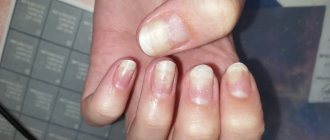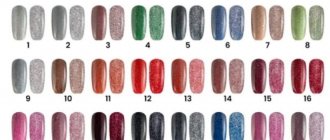A real breakthrough in the field of nail art was the invention of gel polishes. Since that time, women have forgotten about sloppy “peeling” manicures and chipped nails: Gel polishes are loved by millions because they are distinguished by their durability and brightness of colors. With the help of gels, nail extension and correction procedures began to be carried out, and those young ladies who could never boast of the strength of their nails were able to afford incredible experiments with their length and design. Well, the manicure itself has turned into a real work of art. Marigolds have acquired their own style, fashion, and content.
In addition, when using a gel coating, you no longer need to be careful for fear of damaging your manicure. Gel varnishes are resistant to mechanical damage, and moreover, they protect the natural plate from chipping and delamination that occurs under the influence of the environment.
However, not everything is as rosy as it seems at first glance, and gel coating has its own negative consequences, the correction of which sometimes takes more time than you enjoyed with artificial beauty. It’s worth talking in detail about the consequences of an insatiable passion for artificial manicure and how to restore nails after gel coating.
What is the difference between gel polish and shellac
First, you should understand such concepts as gel polish and shellac. Many believe that these are completely different drugs and at the same time advocate for the latter option, arguing that shellac is less aggressive and practically does not injure the nail plate. In fact, shellac, that’s right - “Shellac” is the same gel polish, or rather one of its varieties, or even more accurately a brand, like “Jessica Geleration”, “Color Couture”, “Axxium OPI”, etc. They are all similar in the technology of their use, but have some differences in adhesion to the surface of the nail. For example, “Jessica Geleration” brand varnishes are applied to nails after sanding the plate with a soft buff. When using Shellac gel polishes, it is enough to remove the pterygium near the cuticle and ridges and degrease the plate. In other words, shellac has become firmly associated with gel polishes and is literally synonymous with them, as happened in turn with the Pampers brand of diapers.
Removal of all types of varnish occurs according to the same scheme - the plate is wrapped in a cotton pad soaked in acetone and sealed in foil. However, if to remove shellac it is enough just to pry off the softened layer with a wooden stick, then in the case of other gel varnishes, mechanical action is also necessary - to cut off the hardened words of the gel with a nail file.
Thus, the nail plate undergoes additional thinning. As a result, many have the idea that shellac has a more gentle structure. In fact, this statement is quite controversial, because the same shellac has a more active chemical structure, due to which it has such bonding properties. Other brands adhere to the plate due to the connection with the microvilli of the nail formed as a result of filing.
How to remove shellac with a manicure machine at home: tips
In fact, you can remove shellac yourself using almost the same device that is used in the salon. The only difference is that for the procedure the master usually uses several cutters, which he inserts into the device. They work on a fairly simple principle: the cutter rotates at high speed and thereby removes nail polish. The same can be done with a simple file. This method is used by some masters, but we must give credit to the device, because it does everything carefully when used correctly.
Myths and truth about nail treatment after shellac
Having dealt with the differences, or rather having learned that there are no differences between gel polish and shellac as such, it is worth moving on to considering the issue of nail treatment and how to restore nails after gel.
And it’s worth immediately debunking the most important myth - nails, both after gel extensions and after painting with gel polish and shellac, do not need restoration... unless, of course, the entire procedure for creating a gel manicure and its correction was done correctly.
Important
Important! After a high-quality professional manicure, nail restoration procedures are completely optional. If your nails need rehabilitation measures, it means you or your nail technician has made a number of serious mistakes. Accordingly, you should think about revising your manicure technique or changing your salon.
Judge for yourself, a standard manicure lasts 3-4 weeks. During this time, approximately ¼ of the part of the nail that has not been subjected to any impact has time to grow. An experienced professional simply removes the old coating and applies a new one. Then, at the client’s request, the procedure is repeated again after 3-4 weeks. As a rule, the plate under the gel coating remains healthy; moreover, the artificial coating creates some kind of physical barrier that protects the nails from external influences.
However, all of the above applies specifically to the case if the entire procedure for creating a manicure and removing the old coating was carried out according to all the rules. Otherwise... What happens in the worst case scenario will be discussed below.
How to remove shellac at home without foil?
You don't have to use foil to remove shellac yourself. Just keep in mind that the method is very aggressive. If you use it once, when you really need it, then nothing bad will happen. But it’s better not to resort to it regularly.
So, you will need any nail polish remover with acetone. Please note that you cannot use pure solvent. You will also need a bowl to soak your fingers, as well as an orange stick and heavy cream.
- So, pour some nail polish remover into a bowl.
- Prepare your nails for the procedure by smearing them with a rich cream
- After this, dip your nails into the bowl and wait. The time is determined by the quality of the coating and the amount of acetone in the selected product. Check periodically to see if the varnish has become loose
- When you see that the varnish has softened, start removing the loose layers
Be sure to wash your hands with soap after completing removal and, ideally, also take a recovery bath. As an option, you can make a caring hand mask and then apply cream.
Please note that if you have any wounds on your hands, then this method will not suit you, because it will greatly harm the damaged areas.
Possible negative consequences after using gel coatings
So, let's look at the possible problems when using gel polishes.
- You were unlucky and you came across an inexperienced nail technician, or an overzealous one, and he filed down your nail plate almost to the state of tissue paper. Or perhaps the nail polish removal technology was not followed. Many people simply literally rip off the old coating with their “teeth”, removing the living fibers of the nail along with the varnish. And it also happens that the varnish turned out to be of poor quality or the nail was poorly degreased, and the coating peeled off the plate. And after 2-3 days you again ventured into the extension or coloring procedure. It turns out that the nail is cut down again and exposed to radiation in a lamp. As a result, you get thin nails, very sensitive to external influences, on which it is simply impossible to apply any coating. The plates react to even the slightest change in temperature.
- Another option is that you or your master uses low-quality cheap materials. As a result, the polish chips along with pieces of the nail, or the nail cracks right under the polish. The plate turns yellow, becomes covered with white spots and deep grooves appear. Nails become brittle, chip, peel, and break before they even have time to grow. It is impossible to reapply varnish on such nails; there is simply nothing for it to hold on to.
- Your nails were overexposed in the lamp, or extensions were done very often, and the nail polish removal technology was not followed. As a result, calloused formations have formed under the thinning plate, which stick out unsightly from under the nails, and it is impossible to process the free edge of the nail due to painful sensations when touching the growth. In addition, dark streaks of dried blood are visible under the nails. And the skin of the hands in the nail area peels and looks rough.
- The worst consequence is that the plate was literally cut down to the “meat” and instead of a beautiful manicure, there is an open, raw wound.
- Another unpleasant moment is the resulting fungus. It appears when disinfection rules are ignored and hygiene standards are violated.
It is in these cases that they talk about the need to restore nails.
Methods for resurfacing and nails after using shellac and gel polish
Procedures for restoring or treating nails can be divided into three groups: preventive, home using traditional recipes, and salon. All of them are quite effective, but are not an absolute panacea. They will only help to lighten and improve the appearance of the plates, but for final healing you will have to wait until the nail grows completely. So, first things first.
Interesting
Restorative procedures will only improve the condition of damaged nails and relieve discomfort. A complete cure will occur when a new nail grows.
Preventive procedures
These products should be used by everyone, regardless of whether your nails are damaged or whether you use gel polishes at all.
- The simplest and most basic thing that even those who do not experience problems with nails should not forget is the need to regularly moisturize and nourish the cuticle. It is enough just to rub the oil into the cuticle skin with light massaging movements every day. Following this simple rule will save your nails from possible peeling and drying out, and will preserve the beauty of your manicure for a longer period.
- Balanced diet. If your diet has a sufficient content of microelements, the most important of which is calcium, and vitamins, then your nails will delight you with their healthy appearance. During the period of vitamin deficiency, as a preventive measure, the use of wheel vitamins will not hurt. Please note that they contain vitamins A, E, C and group B - they are responsible for the strength and beauty of nails.
Folk remedies
Many people neglect them, but in vain. They will help you both restore your nails at home and minimize possible troubles in the future. All these tools are easy to use and not expensive in terms of finances. and in terms of their effectiveness they are not much inferior to salon procedures and professional cosmetics.
- Salt baths. It is enough to dilute a tablespoon of sea salt in warm water and soak your nails in this solution for 12 - 20 minutes. For effectiveness, you can add a couple of drops of lemon juice or citrus essential oils to the water. Sea salt will strengthen and saturate your nails with essential microelements, and essential oils and lemon juice will help whiten your nails.
- Iodine mesh. And it is a mesh, and not chocolate nails, as some particularly zealous young ladies like to do, forgetting that the alcohol contained in the iodine solution can dry out the plates.
- Rubbing vitamins into the nail bed. The most common “Aevit” is suitable for this. It is enough to squeeze out the contents of one capsule and rub into the base of the nail.
- Olive oil is no less effective. But in this case it is better to use the unrefined version. It contains the full range of substances your nails need. It is necessary to heat the oil to a comfortable temperature and keep your nails in the bath for 10 minutes. Then, without washing off the oil, wipe your hands dry with a napkin.
- Berry mask. This procedure is popular even among nail specialists. The main thing is that the berries used in the mask are sour. Cranberries, currants, sea buckthorn, etc. are suitable. They contain a high content of vitamin C, which makes the plate stronger. Simply mash the berries and apply the resulting paste onto your nails. The whole procedure takes 10 – 15 minutes.
Salon treatments
Salon procedures will help restore nails both after shellac and after gel polish, even in the most severe and advanced cases. The most effective of them:
- Sealing the nails. The procedure involves applying a special composition, which includes honey and beeswax, to the damaged plates. All this biomass is literally rubbed into the nails, after which a protective film similar to the natural nail layer is formed on them. After this procedure, the nails become elastic, their fragility decreases and a healthy appearance returns.
- Another popular procedure that has a complex effect on both the skin and the restoration of nails after gel polish is paraffin baths. They will saturate the skin and nails with the necessary elements, slow down the aging of the skin of the hands and eliminate peeling and splitting of the nails. The procedure takes 20 – 25 minutes, and the effect lasts for a long time.
- Perhaps the most popular remedy that helps both strengthen nails after shellac and is used as a preventive measure is the use of special medicinal coatings. You can go to a salon for this procedure, or you can purchase the product at a pharmacy or specialty store and apply it yourself. The main thing is to read the ingredients carefully. It is important that the product contains silk fibers, vitamins, calcium, and minerals - they help accelerate nail growth, strengthen the nail plate, and prevent the formation of new cracks and chips.
That’s probably all about how to treat nails after shellac and other gel polishes. Many of these treatments can be used as preventatives. But the main rule in creating an attractive manicure is following all the rules and using quality products. Then you will not have to undergo a lengthy procedure to restore your nails.
The best way to recover
At home, the easiest way to treat nails is an alcohol solution of iodine. It is considered the best and simplest means of restoring the nail plate. It is necessary to lubricate your nails with a cotton swab with iodine up to twice a week at night. In the morning there will be no trace of yellowness left - the iodine will be absorbed. This product strengthens and whitens the nail plate.
Iodine is a proven way to get rid of nail fungus
